The very best way to cook your beef to proper degree of doneness is by using the internal temperature as a guide to capture the cooked beef temperature. This post will explain each type of beef, varying temperatures of doneness, and the best tools to use!
For a medium rare steak, pull it off the heat at 130°F (54°C) so it reaches 135°F (57°C) while it rests. The beef should have a warm red center and be 135°F for a medium rare cut of beef.
Meat Temperature Chart (°F & °C)
Always remove beef from heat 5-10°F before your target temperature to allow for carryover cooking (it will rise another 5-10°F as it rests).
| Doneness | Remove from Heat | Target Temperature |
| Rare | 120°F (49°C) | 125°F (52°C) |
| Medium-Rare | 130°F (54°C) | 135°F (57°C) |
| Medium | 140°F (60°C) | 145°F (63°C) |
| Medium-Well | 145°F (63°C) | 150°F (66°C) |
| Well Done | 150°F+ (65°C+) | 160°F+ (71°C+) |
Pro Tip: Always rest your beef for 5-10 minutes after cooking. This locks in juices for maximum flavor.
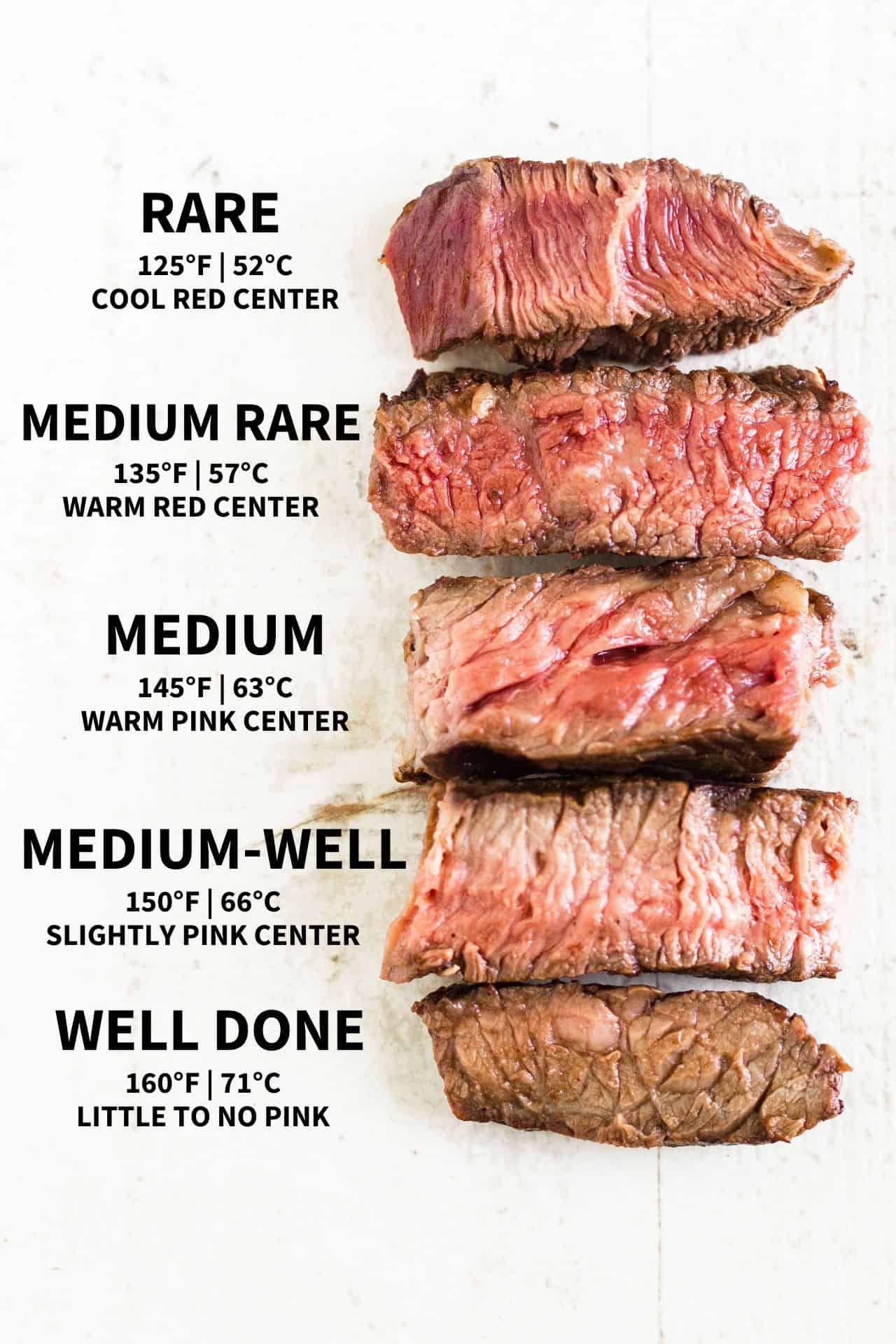
Need more beef tips? Learn how to reheat leftover steak, how to cut flank steak, or a step-by-step guide for how to grill ribeye. Or browse hundreds of beef recipes!
Table of Contents
- Meat Temperature Chart (°F & °C)
- Why Internal Beef Temperature Matters
- When to Take the Meat Off the Heat
- What Temperature Should Beef be Cooked to in Celsius?
- Internal Temperature of Steaks
- How to Properly Measure Beef Temperature
- Internal Temperature of Ground Beef
- Internal Temperature of Roasts
- Storage & Reheating Beef Properly
- Best Digital Meat Thermometers
- Best Beef Recipes
Why Internal Beef Temperature Matters
Have you ever been to a restaurant and wondered how they cook their burgers and steaks so perfectly? Though they may have professional chefs working their magic, you can get the same result at home by using a meat thermometer.
Using an instant-read thermometer is the #1 way to tell when your beef is cooked to the right temperature (see below for how to properly use a meat thermometer). There is nothing worse than spending money on a cut of beef and overcooking it, especially expensive cuts like prime rib.
Whether you’re making chuck roast, ground meat, the perfect steak, or a roast, this post outlines all you know to know about cooking meat to a delicious and safe temperature.
Want to learn more about temperatures and times? Learn how long to grill chicken breast, how long to grill pork tenderloin, how long to grill pork chops, and how long to bake chicken wings.
Other types of protein! Always cook poultry (chicken & turkey) to 165°F, lamb to 145°F (medium-rare), ham to 145°F (or 165°F for reheating fully cooked ham), and salmon to 145°F for safe consumption.
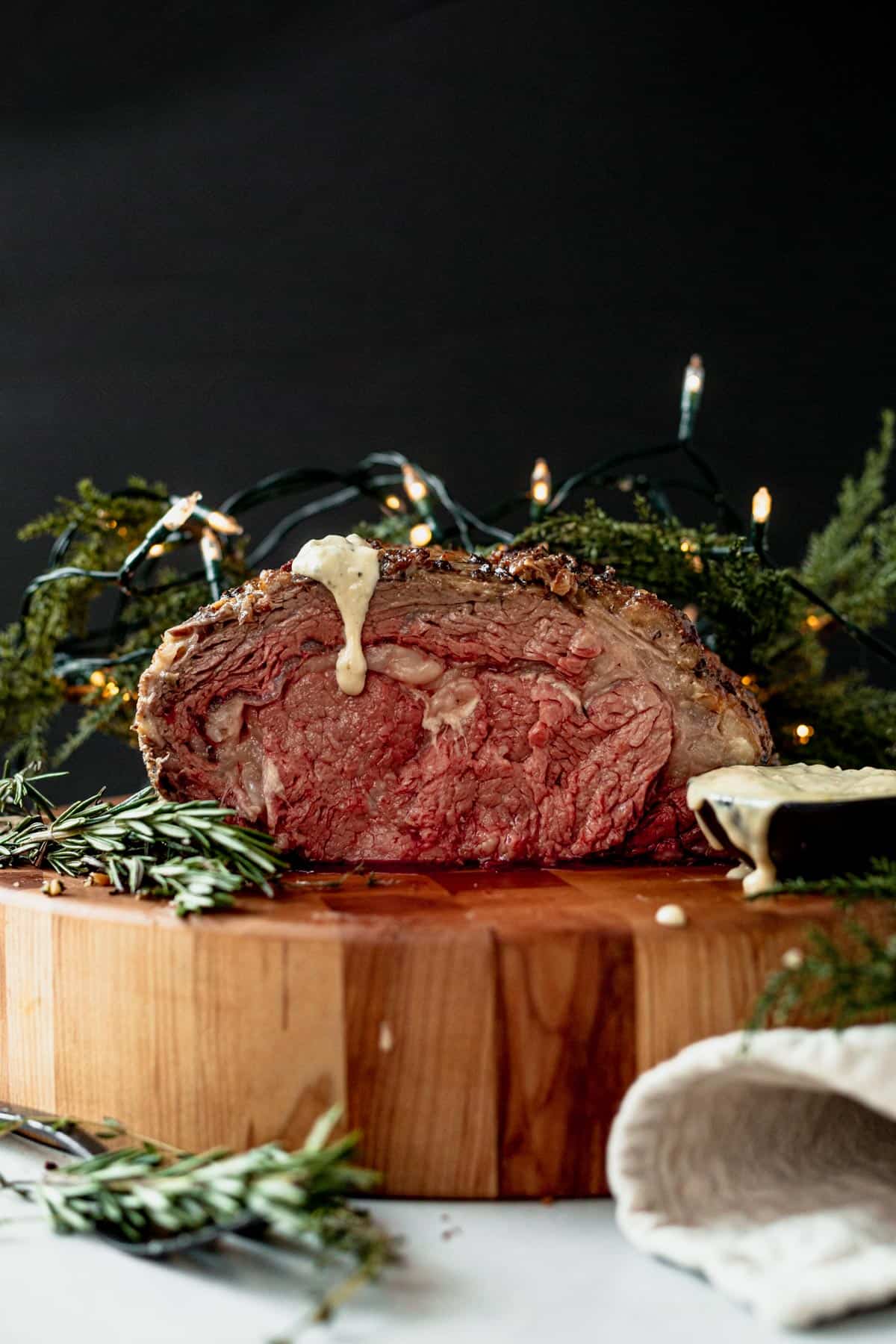
When to Take the Meat Off the Heat
Remove the steak from the heat 5-10 degrees before reaching your desired temperature because it will continue to rise 5-15 degrees (also known as carry-over cooking). Allow 15-20 minutes of standing time.
What Temperature Should Beef be Cooked to in Celsius?
- Rare: 52°C
- Medium rare: 57°C
- Medium: 63°C
- Medium well: 66°C
- Well done: 71°C and above
Food Safety Guidelines for Cooking Beef
To avoid foodborne illness, follow these USDA-approved beef safety tips:
Safe Internal Temperatures
✔ Ground Beef: Always cook to 160°F (71°C) to kill bacteria like E. coli.
✔ Steaks & Roasts: Safe at 145°F (63°C) with a 3-minute rest time.
✔ Rare beef (120-130°F) is not recommended for food safety, especially for young children, elderly individuals, or pregnant women.
Danger Zone: 40-140°F (4-60°C)
✔ Harmful bacteria multiply rapidly between 40-140°F.
✔ Never leave beef at room temperature for more than 2 hours (or 1 hour if the temperature is above 90°F).
Internal Temperature of Steaks
Cooking steaks at higher temperatures gives you a delicious sear on the outside with a perfectly tender inside. Somewhere between 450-500 degrees f is the best temperature to grill steaks. But what about the internal steak temperature?
- Rare steak (I don’t recommend this): Pull it off the heat between 120-125 degrees f for a target temperature of 125°F.
- Medium-rare steak: Pull the steak off the grill when the internal temperature reads 125°F. The final temperature should be 135°.
- Medium steak: Remove the steak from the heat when it reaches 135°F, with a target temperature of 145°F.
- Medium well steak: Remove the steak from the heat when the internal temp reaches 145°F for a 150°F target temperature.
- Well-done steak (please don’t do this): Remove the steaks from the heat at 150°F or above, for a 160°F target temperature.
Success tip: pulling the steak off the grill 10-15 degrees before the target temperature is called carryover cooking. This is the time where the internal cooking temperature continues to rise while the steak rests. The rest time brings the internal temp up and locks in all the juices at the same time. This will give you the best steak!
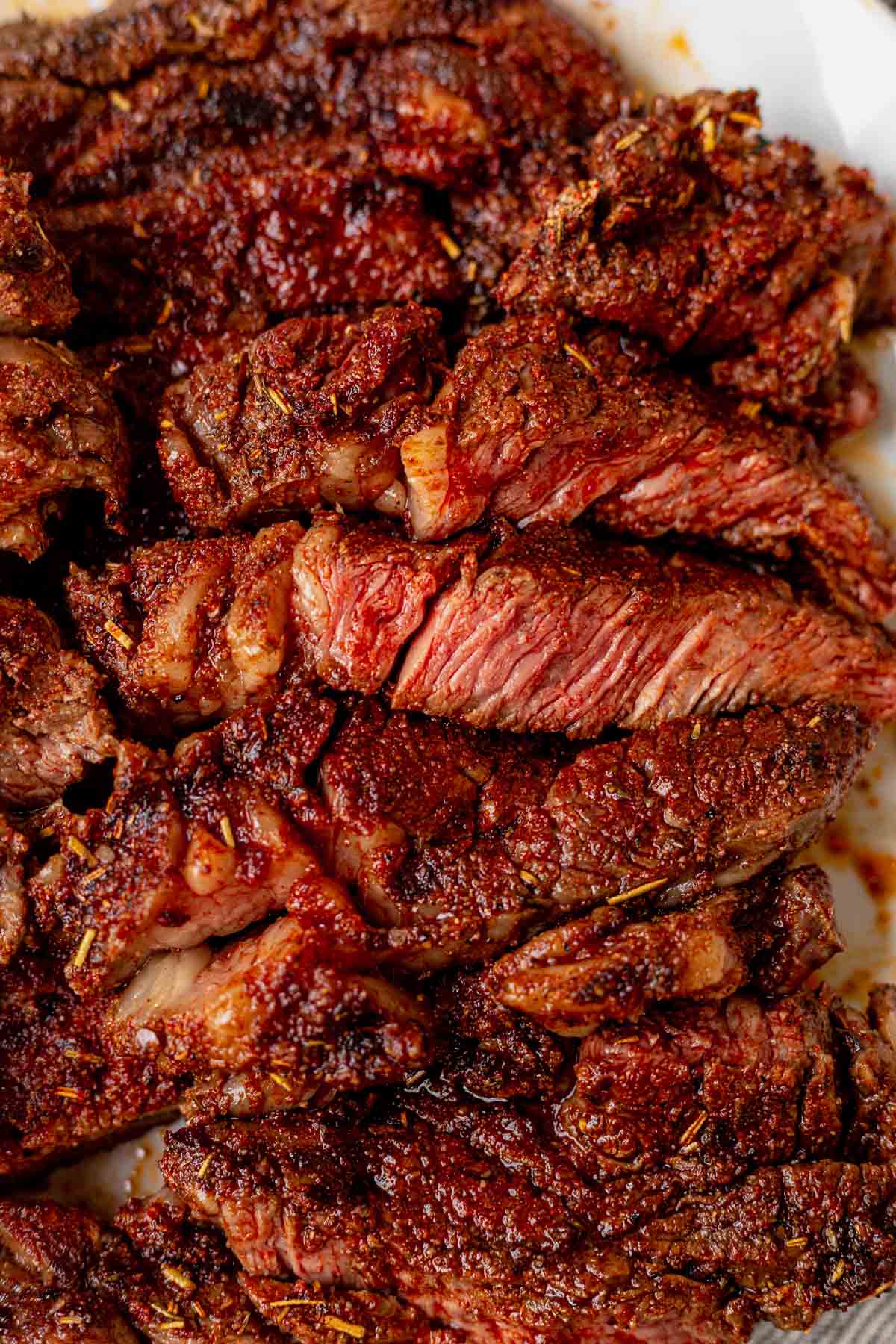
How to Properly Measure Beef Temperature
For ½ inch thick or more steaks, use a meat thermometer to insert horizontally into the thickest part of the meat and wait for the temperature to read about 10 degrees below these target temperatures: 145°F (medium-rare), 160°F (medium) or 170° (well done).
- Insert a meat thermometer horizontally into the thickest part of the beef.
- Avoid the thermometer resting in fat or touching bone.
- For the most accurate reading, use a high-quality food thermometer that measures quickly. A good thermometer is worth the money!
Remember: remove the steaks from the heat source prior to the desired temperature to allow for carry over cooking!
Internal Temperature of Ground Beef
Ground beef should always be cooked to a safe 160°F. Ground beef includes all recipes that have ground beef as the base like burgers, meatballs and meatloaf. Eating raw meat is the last thing you want! The safe minimum internal temperature of ground beef is 160.
The color of the ground beef isn’t always a reliable indicator for doneness so use a meat thermometer to determine the internal temperature to ensure it’s thoroughly cooked. Insert the thermometer into the thickest part of the beef until it reaches a safe and savory 160°F.
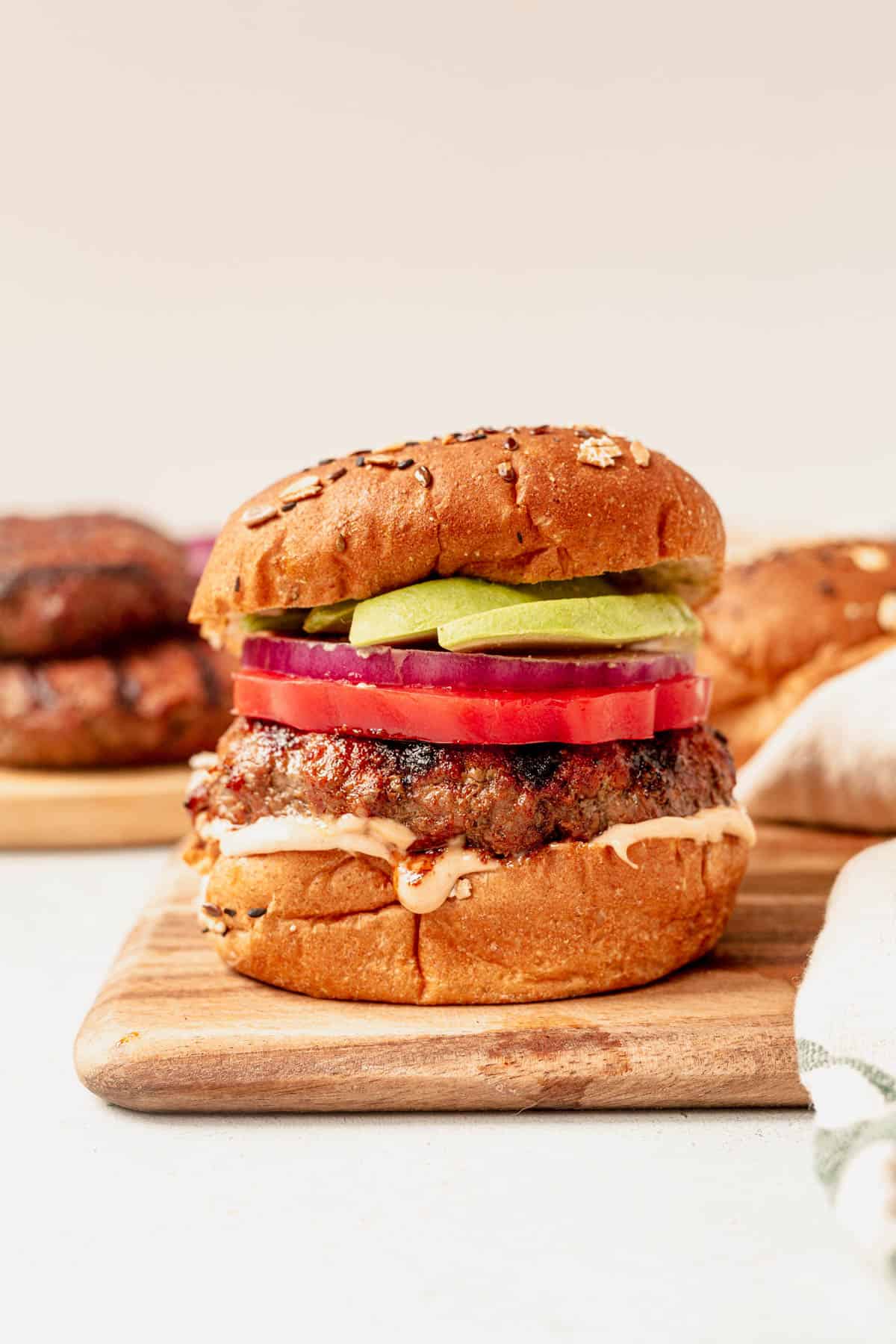
Internal Temperature of Roasts
There are two ways to check the internal temp of a roast: place an oven safe thermometer in the thickest part of the beef prior to cooking and leave it in throughout the cooking process or use an instant read thermometer after the cook time is complete.
Tough cuts like roasts cook low and slow (instead of on high heat like steaks). However, the internal temperatures remain the same!
Roasts include cuts of beef like round roasts, rump roasts and chuck roasts and their internal temperature should read 145°F (medium-rare), 160°F (medium) or 170° (well done).
Read more about determining doneness from The Ohio Beef Council and for an even more in depth guide to specific cuts, temps and cook times check out these oven roasting guidelines.
Storage & Reheating Beef Properly
✅ Refrigerator: Store cooked beef in an airtight container in the fridge at 40°F (4°C) within 2 hours of cooking—steaks & roasts last 3-5 days, while ground beef lasts 1-2 days.
✅ Freezing: Wrap leftovers tightly in plastic wrap, foil, or vacuum-sealed bags to prevent freezer burn—steaks & roasts last 6-12 months, and ground beef lasts 3-4 months; thaw in the fridge, never at room temperature.
✅ Reheating: Warm steaks & roasts in a 250°F oven, reheat ground beef in a skillet over medium heat, or use a microwave on low power, covering with a damp paper towel to keep moisture.
Best Digital Meat Thermometers
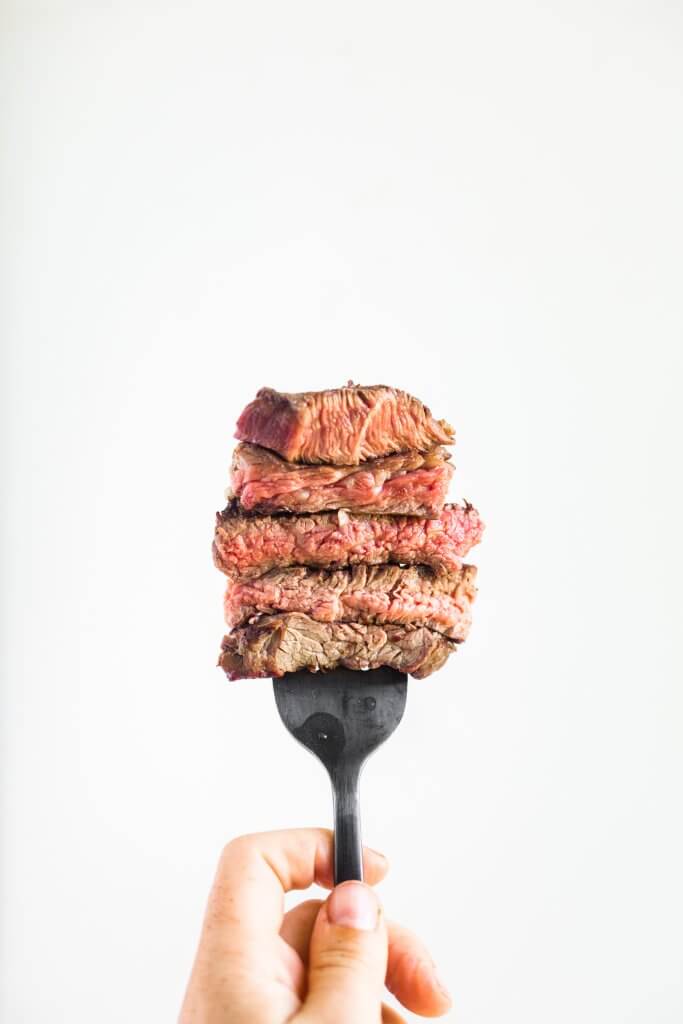
Best Beef Recipes
Browse hundreds of beef recipes depending on what you’re craving!
Steak Recipes
Steak bites and potatoes, healthy IP mongolian beef, beef tenderloin, IP beef stroganoff, one pan garlic steak and potatoes, stuffed flank steak, steak fajitas
Ground Beef Recipes
Mexican beef and rice, IP spaghetti, teriyaki burger
Roast Recipes
Beef ragu, Garlic Herb Standing Rib Roast, sweet potato beef stew, korean beef tacos, IP Pot Roast
This post is sponsored by The Ohio Beef Council. All thoughts and opinions are my own. Thanks to brands like them for believing in me and allowing me to share free information and recipes with you!
This post may contain affiliate links. Read our disclosure policy.

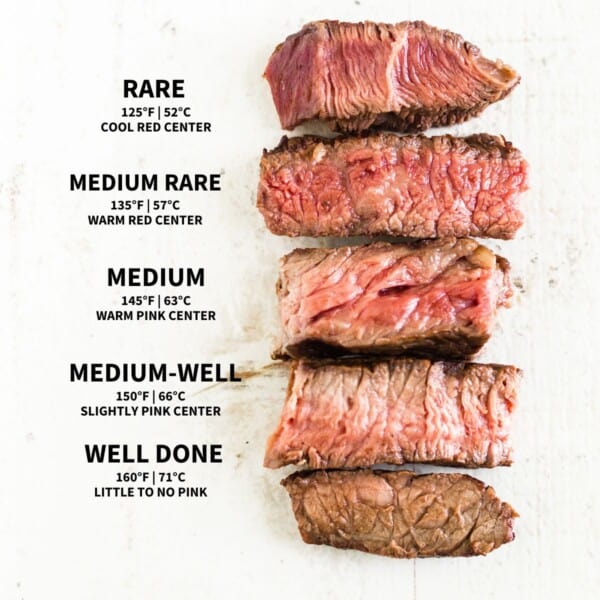
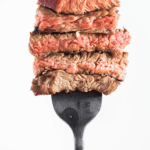









Hey Molly,
Question- I have a couple of friends who’ve recently told me to cook at what I think is a LOW temp to get their ideal roast. My friend Mark insists the perfect way to oven cook say, an eye of round roast is to brown on all sides stove top, then pop it in the oven w a top on it at 285 for close to 2 hours.
I’ve promised him I’ll try it, oh! -with 1cup of beef broth for a 2lb roast a tad more if there’s no fat on it to keep the moisture required. My fear is that this will produce a dry, overcooked product. Any thoughts before I take the dive to try his method?
Thanks-
Hey Molly,
I think all your temp instructions made perfect sense and THANK YOU for testing and tweaking so I don’t have to! – Question- I have a couple of friends who’ve recently told me to cook at what I think is a LOW temp to get their ideal roast. My friend Mark insists the perfect way to oven cook say, an eye of round roast is to brown on all sides stove top, then pop it in the oven w a top on it at 285 for close to 2 hours.
I’ve promised him I’ll try it, oh! -with 1cup of beef broth for a 2lb roast a tad more if there’s no fat on it to keep the moisture required. My fear is that this will produce a dry, overcooked product. Any thoughts before I take the dive to try his method?
Thanks-
Wow…apparently people in Metric System countries like their steaks more rare. The Celsius conversions aren’t even close to matching up. Not even rounding to the nearest 5 degrees. That 65 degrees Celsius Medium is only 149 degrees Fahrenheit. Even 70 degrees C would be less than 160 F. Really not hard to do the math. Not even for an unknown “blogger”
Hi Molly, I say thanks! You made it very clear to take roast out 10-15 degrees before desired temp!
These temps are completely wrong. 135 rare?! What planet are you on?
Hi Joe! Thanks for your feedback. I spent time researching and testing and ran all of these numbers by my friends at the Ohio Beef Council and they confirmed these are correct. Make sure to account for carry over cooking so you’ll want to pull them off the heat about 10 degrees before these numbers.
I would suggest that the temps published for doneness is AFTER carryover temps are reached meaning to take the meat off the grill (or oven) 10-15 degrees BEFORE the desired temp so it doesn’t get overcooked to your liking, ie if you desire a medium rare roast or steak, take the meat off the grill when it reaches an internal temp of 130-135 degrees so the carryover cook reaches the desired 145 degrees. Most of the temps published never mention this. I have overcooked prime rib (to my liking) by waiting for the internal temp to reach 145 degrees which brings it to 160 degrees (while resting) to be carved making it barely pink. You did make a note after the list of temps but most lists never mention this.
Hey Ed! I have that included in the post, but it’s probably a good idea to make it a little more bold so people don’t miss it. Thanks for the suggestion!
Unless your implementing a HACCP program
Are you just making these facts up because the temperatures you have for beef Are completely wrong and off by at least 20°F. You are missed leading people to an over cooked piece of steak or piece of beef.
Hey Nathan! I’m not making these up. I spent hours testing and researching oven temps before hitting publish. I’ve spent days at the National Cattleman’s association learning how to cook beef from their in house chefs. You can read more about their cook temps on their website where I fact checked all of my information. Those are the correct temps of when they should be served. I mention in my post that you need to remove them from the heat up to 15 degrees before they reach those to allow for carryover cooking. I like my steak medium rare so I take it off the heat when it reaches 130. The steaks you see in my image were all tested and taken by me and were cooked to the degrees I shared in my post.
https://www.beefitswhatsfordinner.com/cooking/determining-doneness#:~:text=For%20steaks%201%2F2%20inch,done%20is%20170%C2%B0F.
These temps led me to overcook steaks for the entire family. Please calibrate your thermometer.
I agree…these temps are about 15°F too high. Medium rare is 130°F at rest, which means (depending on your cooking method) you should pull to rest at an internal temp of around 125°F. This is for a 1″ Boneless Ribeye when cooking via the Arroser or Sautee & Baste method. The carry over will raise the temp about 5°F before plateauing.
Agreed, 145°F is way too high for medium rare. Also, to quote, “For 1/2 inch thick or more steaks, use a meat thermometer to insert horizontally and wait for the temperature to read just below 145°F (medium-rare)”. What exactly is ‘just below’? Is it 10°F, is it 5°F, is it 3°F? This is probably a moot point because 145°F will not produce a medium rare steak – it will be well into medium.